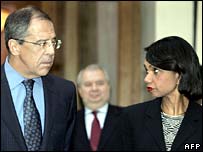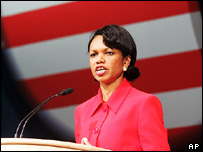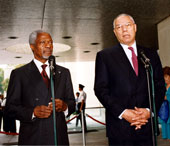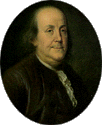| (insert your NIE or newspaper logo here) |
Weekly Online LessonOnline Lesson ArchiveGrade Level: 6-8
|
Secretary of State Seeks Diplomatic Support
 Beginning
Monday, October 10, 2005, U.S. Secretary of State Condoleezza Rice spent
a week treading through some tough political terrain.
Beginning
Monday, October 10, 2005, U.S. Secretary of State Condoleezza Rice spent
a week treading through some tough political terrain.
Rice visited government officials in Kyrgyzstan, Afghanistan, Kazakhstan, Tajikistan, Russia, France and the UK, promoting diplomatic cooperation on a variety of hot topics.
Among other issues discussed during her visits, Rice asked many of the nations to pressure Iran to return to nuclear talks with the European Union.
The U.S. fears Iran's efforts to enrich uranium supplies will ensure that country's goal of attaining nuclear weapons, which could be a threat to American and global security.
Returning to the U.S. on Sunday, her tour seems less successful than she and the Bush Administration had hoped. While all of the nations Rice visited are generally American allies, they also have an interest in maintaining supportive relationships with Iran and others in the region.
Such is the world of diplomacy. Every diplomat must juggle his or her own nation's interests with those of others, trying to strengthen ties with allies while curbing the power of those who may threaten national or global security and peace.
To get an idea of the demands and difficulties diplomats face, this week you'll find out what the Secretary of State does and what it takes to be a diplomat.
The State of Diplomacy
 Start
exploring diplomacy at Future
State: The US Department of State for Youth site.
Start
exploring diplomacy at Future
State: The US Department of State for Youth site.
Begin by finding out Why Diplomacy Matters.
Here, you'll discover the nation's goals to Protect America, Advance Global Interests, Gain International Understanding, and Support Foreign and Civil Services.
Why exactly is diplomacy our first and best line of defense against perceived threats? What is the central goal of U.S. foreign policy? In what ways does the State Department work to achieve that goal?
How does the State Department promote global understanding? What are the similarities and differences between the Foreign Service and the Civil Service?
Now that you know why diplomacy is important, find out Who some of today's diplomats are.
First, Meet the Secretary of State, Condoleezza Rice. Read her Biography for more detailed information about her background and experience.
 Next,
learn more about the Duties
of the Secretary and how Creation
of the Position originally came about.
Next,
learn more about the Duties
of the Secretary and how Creation
of the Position originally came about.
What previous experience did Rice have that qualified her for the job? What is the Secretary's formal relationship to the President?
In what ways does the Secretary oversee or influence relations between the United States and other nations?
You can also explore some of the Travels of the Secretary of State, to see where Rice has traveled and for what reasons.
Next, review Former Secretaries of State and their Travels. How do their backgrounds of experience and education compare to one another? Do there seem to be any commonalities among them?
Do the Travels of Colin Powell offer any insight into ongoing issues Rice may be involved with during her term?
The Secretary is not alone in the juggling of foreign affairs. To find out who else is involved, Meet Others in the State Department.
 Begin
by meeting some of the Under
Secretaries and Assistant
Secretaries.
Begin
by meeting some of the Under
Secretaries and Assistant
Secretaries.
What are the different areas the Under Secretaries oversee? What do the various Assistant Secretaries do? How do these support the duties of the State Department?
To whom do the Under Secretaries and Assistant Secretaries report? What previous experience qualified these secretaries for their current positions?
What are the similarities and differences between the Secretaries and the Ambassadors?
Although today's diplomats very directly influence U.S. foreign policy and decisions, in many ways they have built upon the relationships forged by former diplomats.
To uncover the history of foreign affairs, explore When in the World American diplomacy mattered.
 Open
the interactive Timeline. Start your journey by meeting the first U.S. diplomat, Benjamin Franklin,
and learn how he and others cultivated the young nation's foreign affairs
from 1776
to 1783.
Open
the interactive Timeline. Start your journey by meeting the first U.S. diplomat, Benjamin Franklin,
and learn how he and others cultivated the young nation's foreign affairs
from 1776
to 1783.
Why was French Assistance during the War of Independence crucial to our sovereignty? What role did Franklin play in French relations?
What diplomatic responsibilities did John Jay, John Adams, and Francis Dana have? Who was the first U.S. Secretary of Foreign Affairs?
Continue through the timeline, reviewing each era's highlights and key figures:
What primary events—related to geography, natural resources, culture, economics, etc.—called for diplomatic talks between two or more parties? How exactly did these negotiations shape today's circumstances—for example, boundaries, trade relations, American culture, an so on? What happened when diplomacy failed?
In what ways did history's various diplomatic players influence events and each other?
Newspaper Activities
Browse current issues of The Salt Lake Tribune to find news about U.S. foreign relations. What is the Secretary of State saying about the results of her recent visits to Asia and Europe? What (and where) are Rice's biggest concerns? What are diplomats she met with saying about their conversations and interests? In what ways are the foreign diplomats supportive or non-supportive of the U.S.? What are the reasons for their stance on certain issues? What are other American diplomats doing to support the State Department's efforts and goals? What other issues are diplomats in other countries concerned about, and what steps are they taking to resolve them? What acts of diplomacy can you identify on your state or local level?
© Copyright 2005
Learners Online, Inc.
